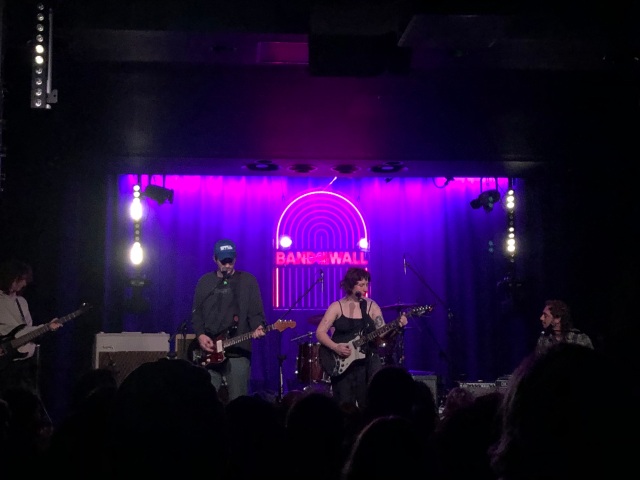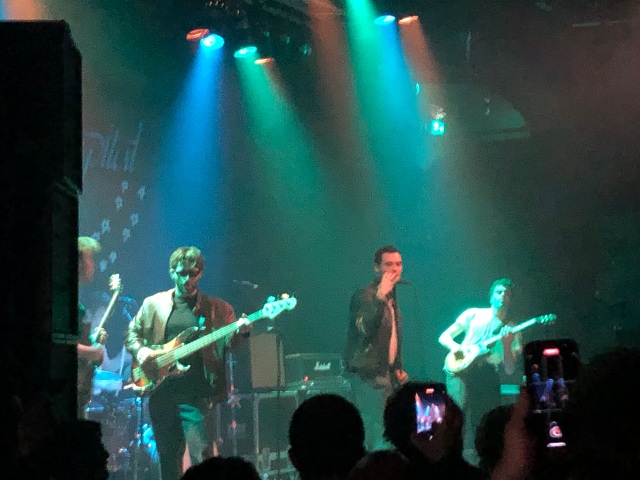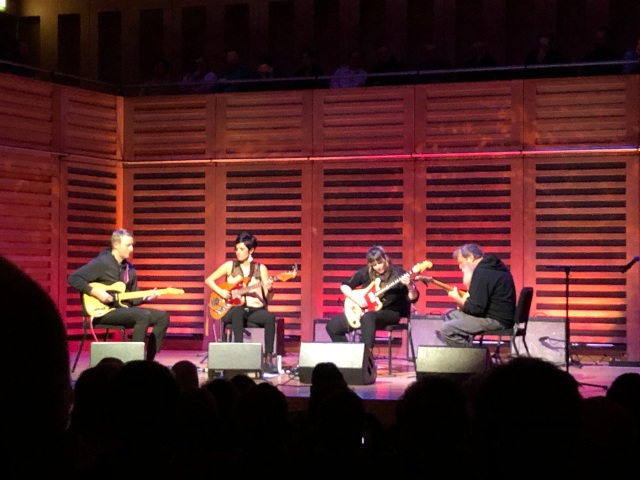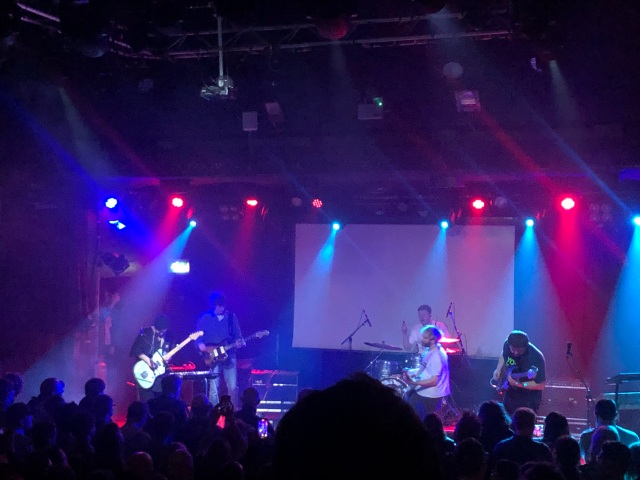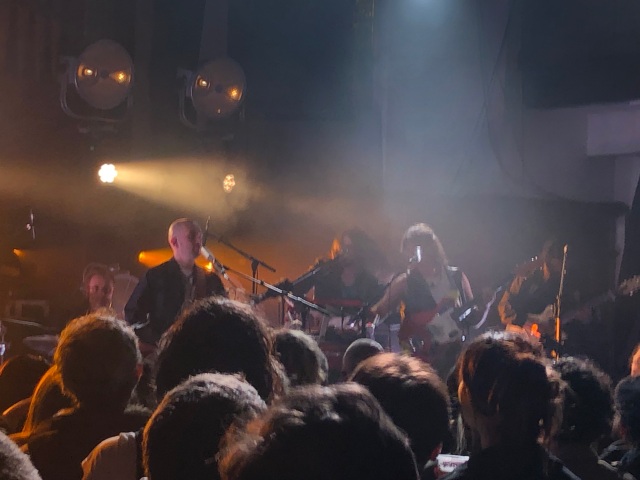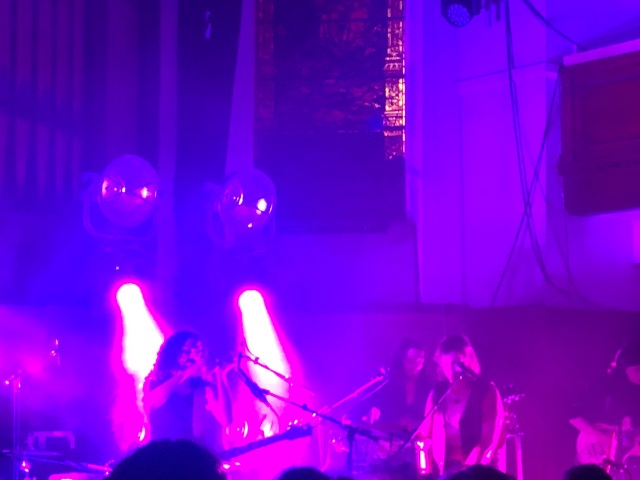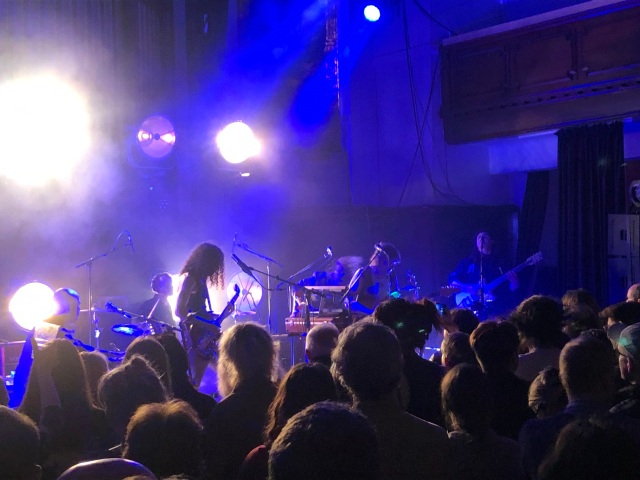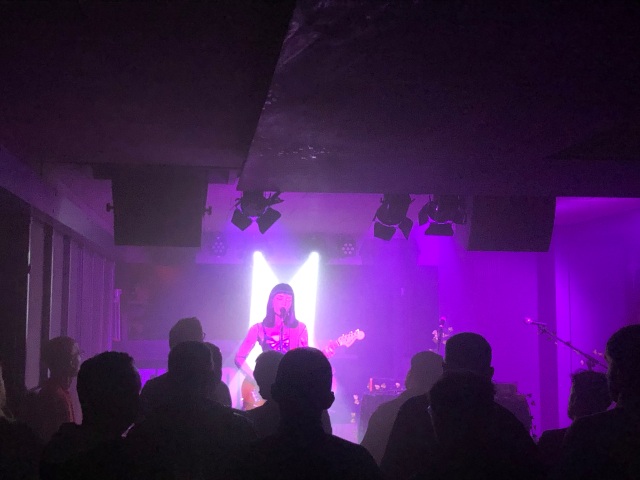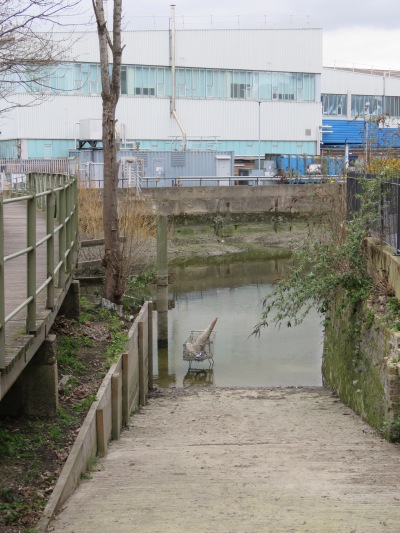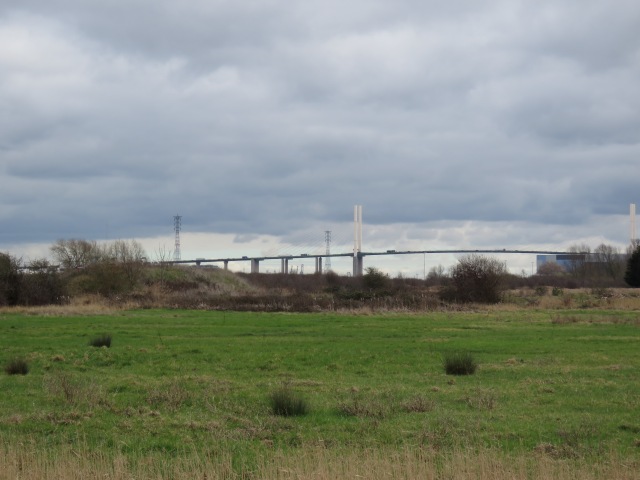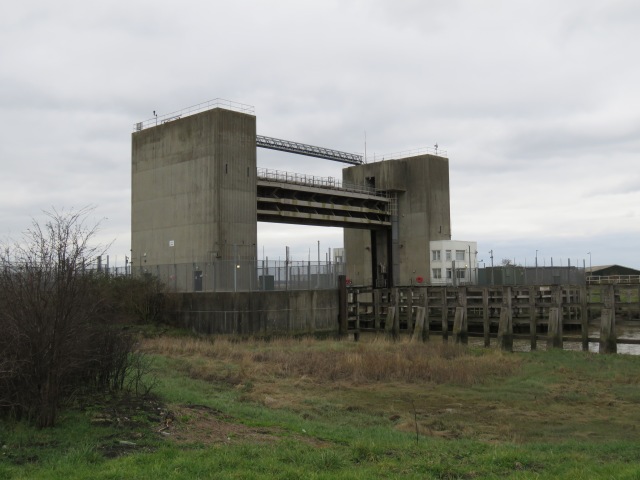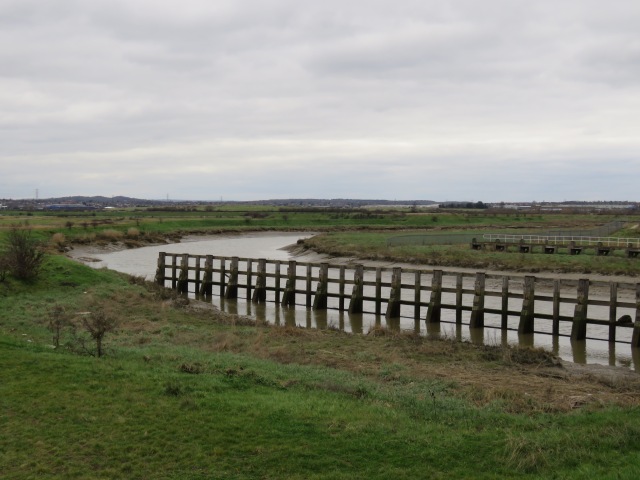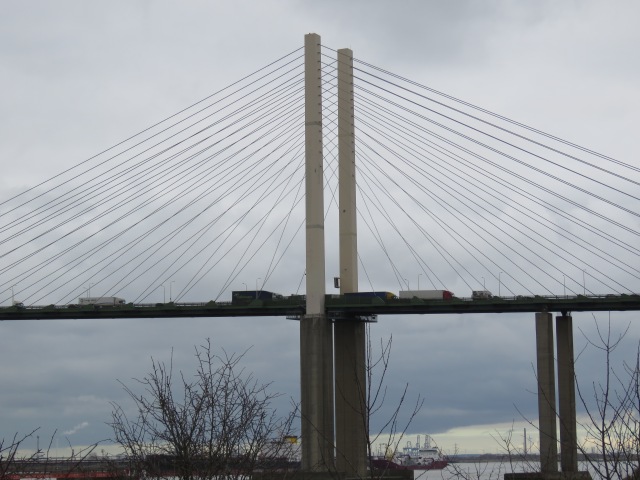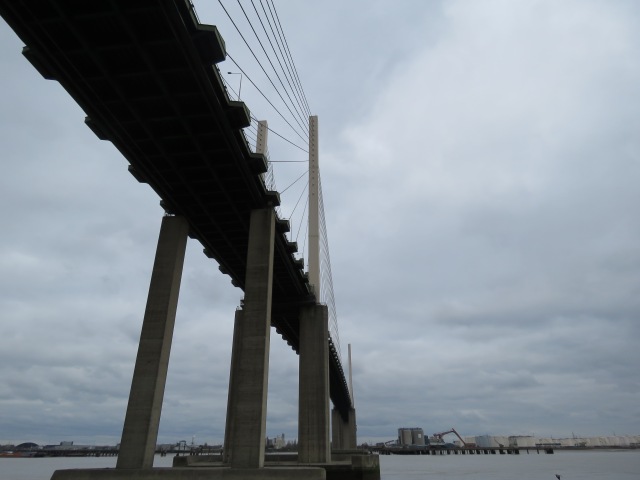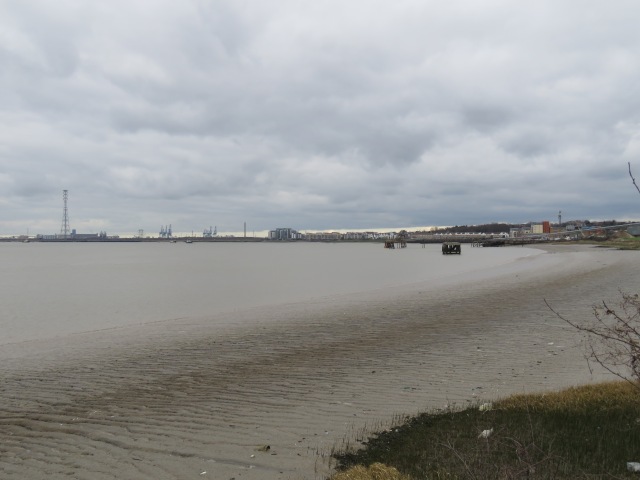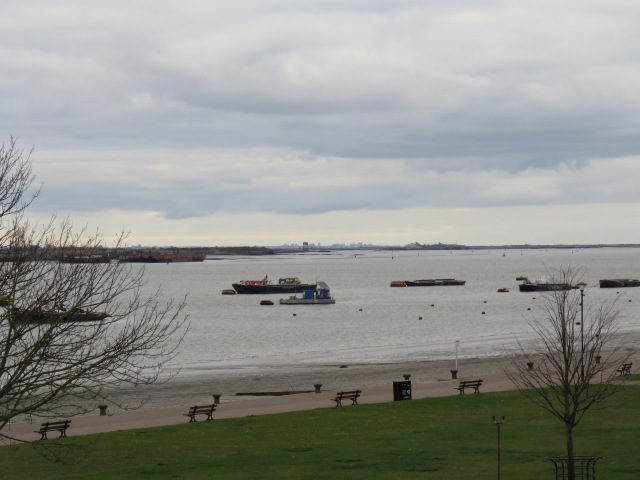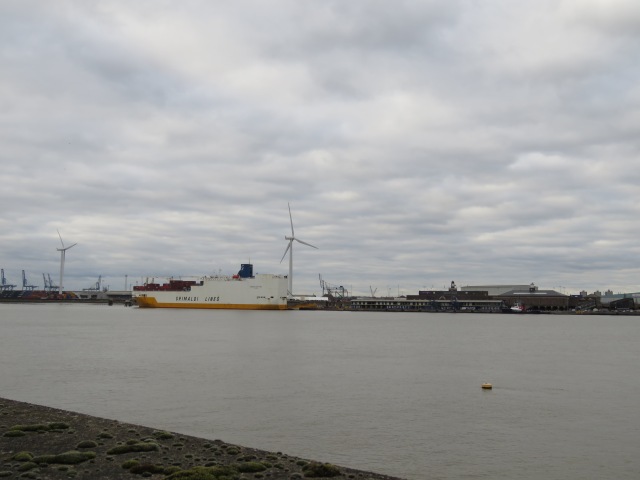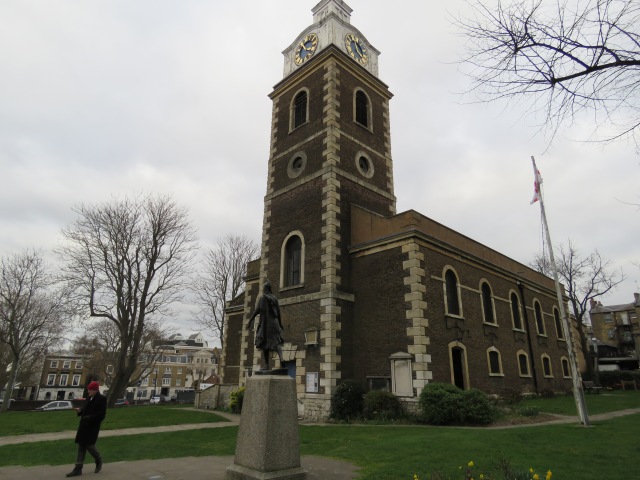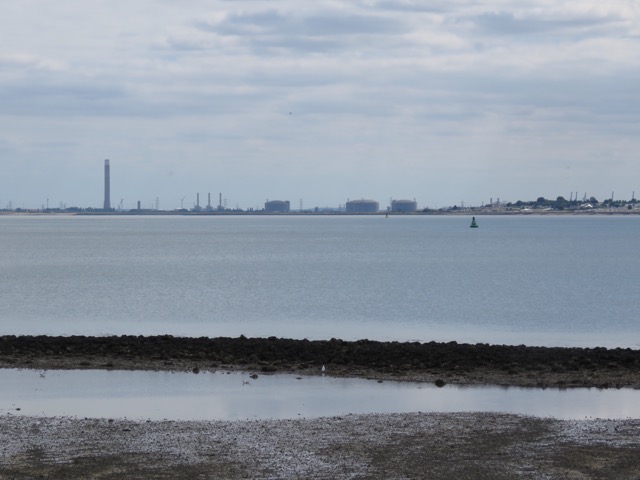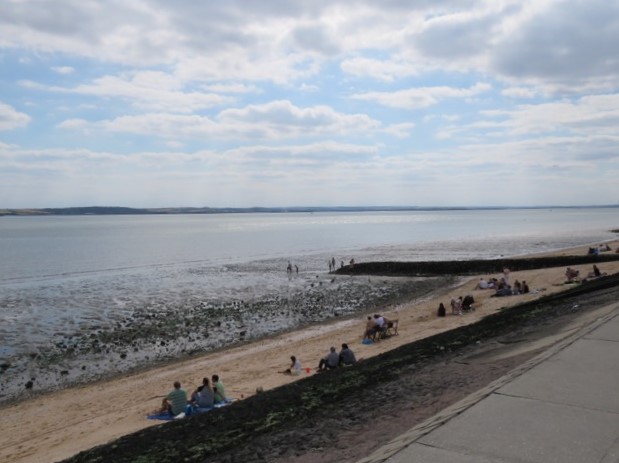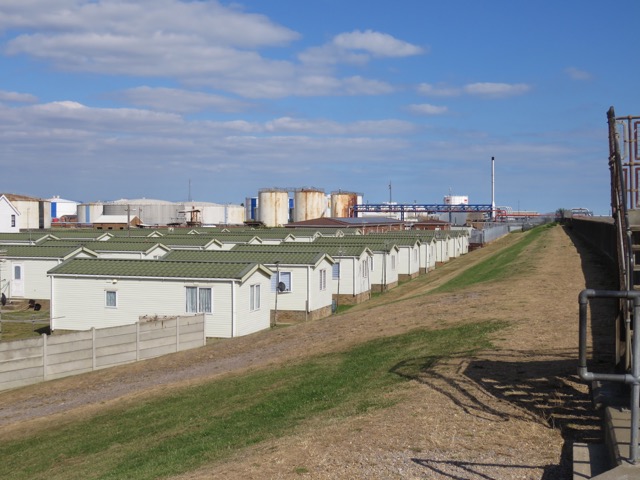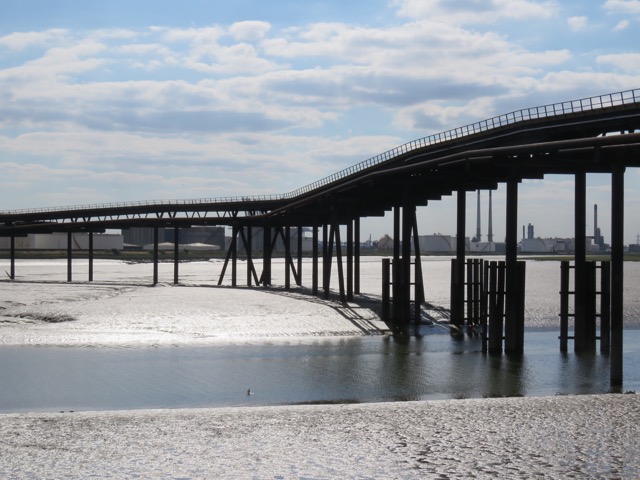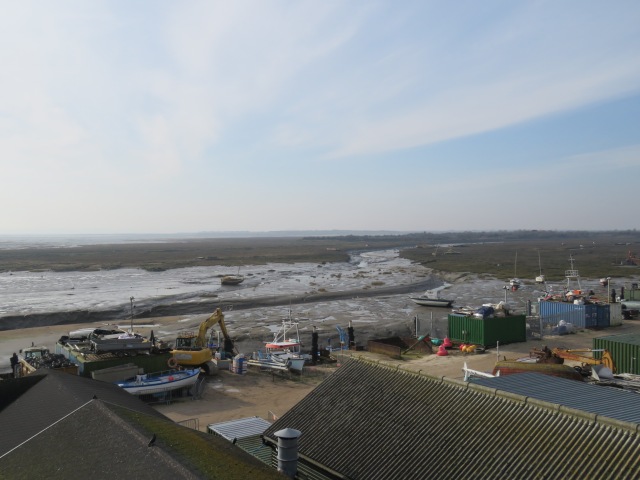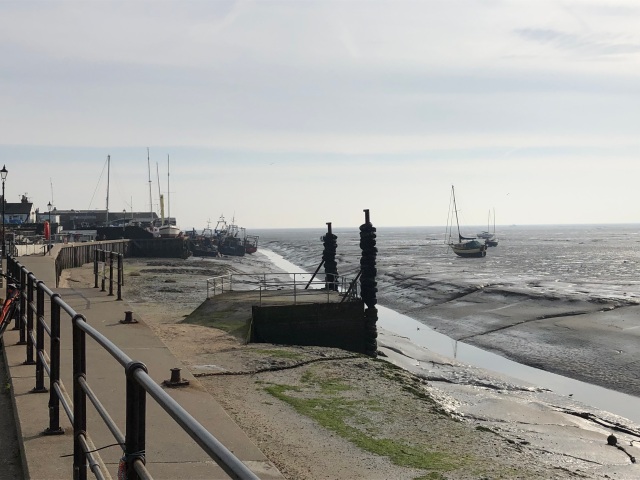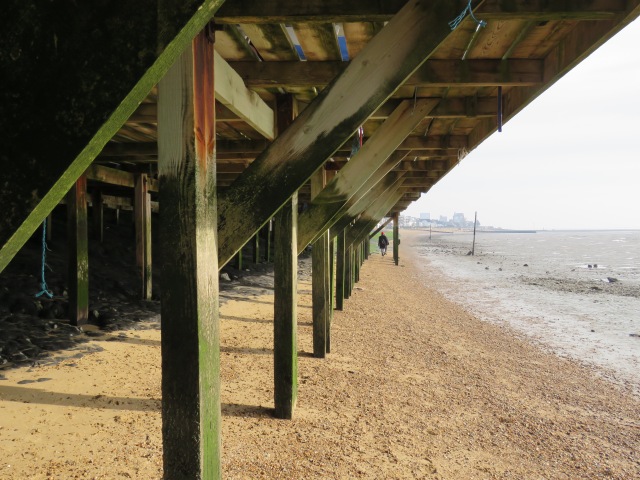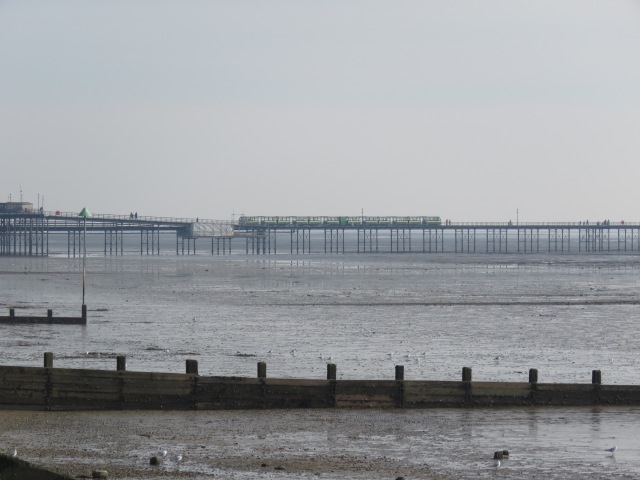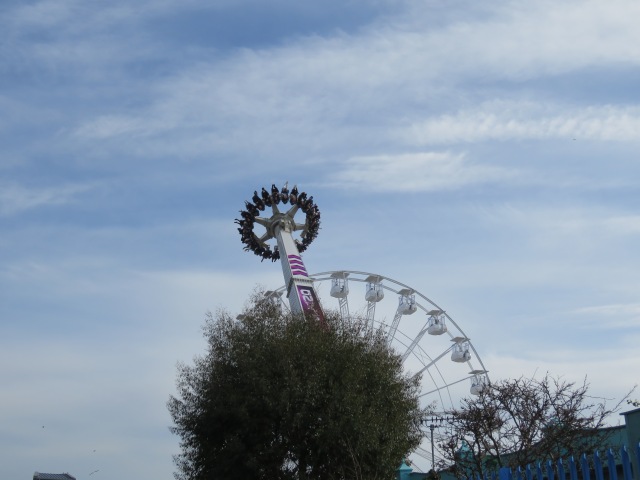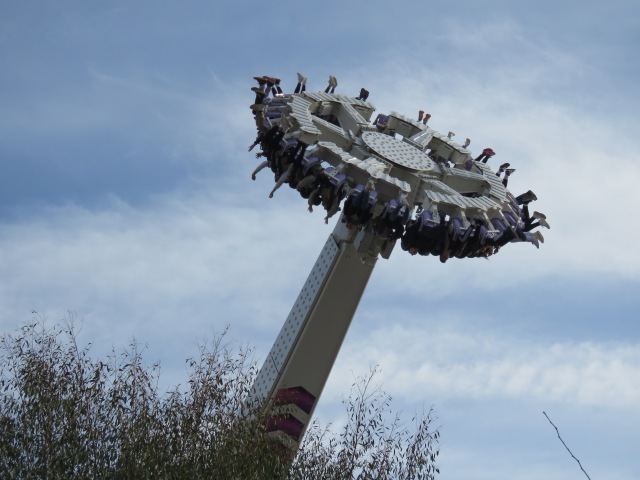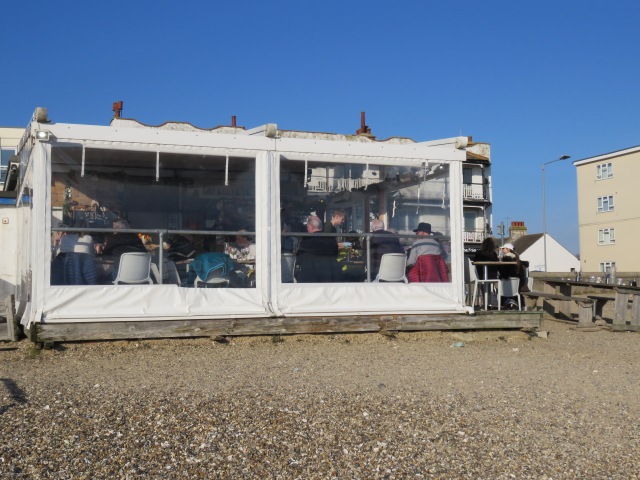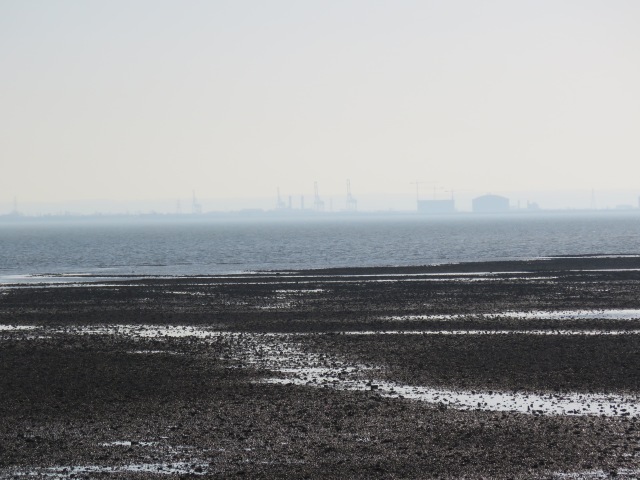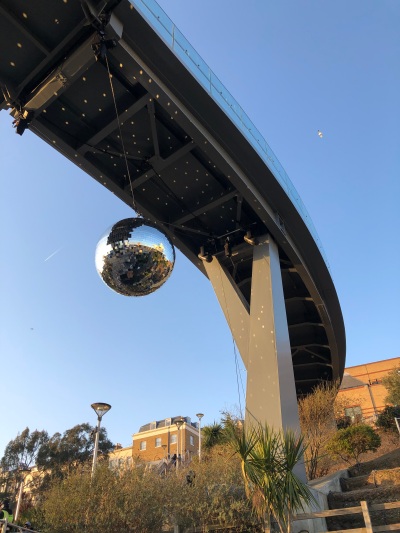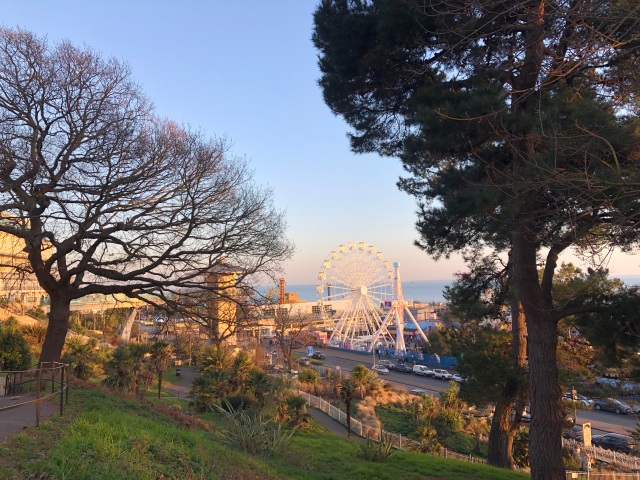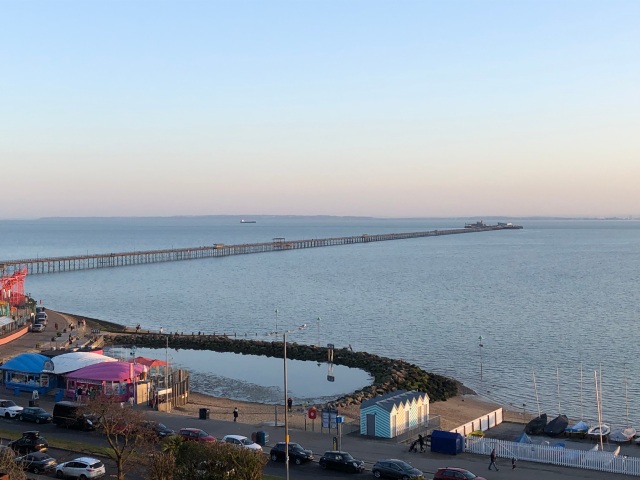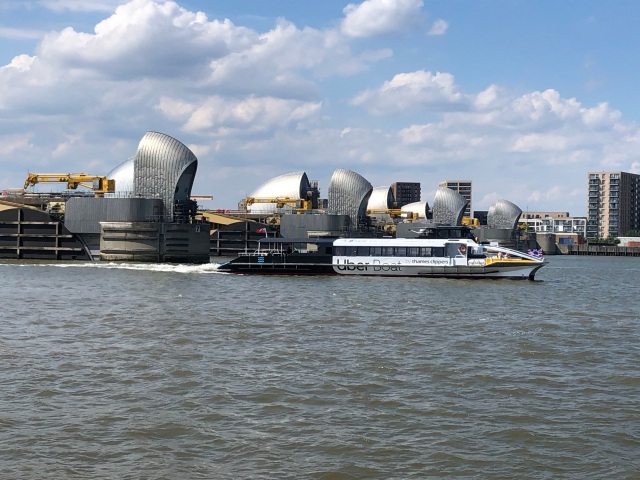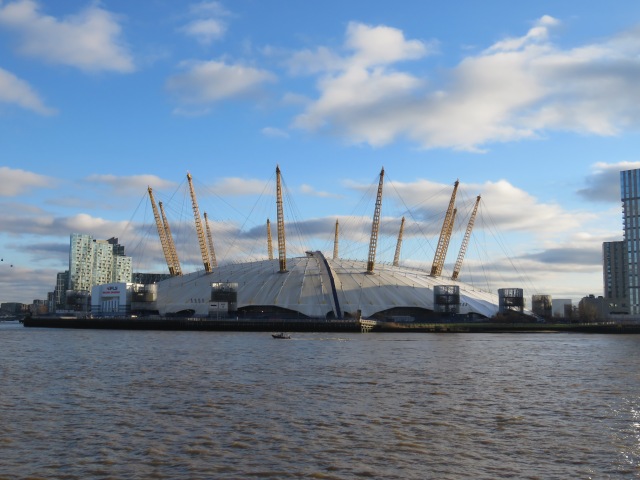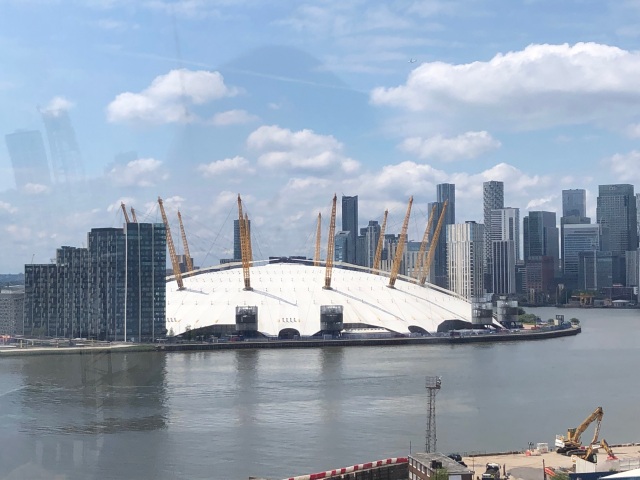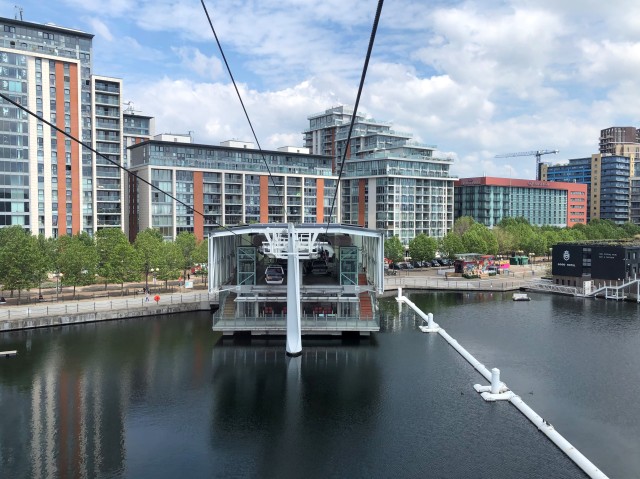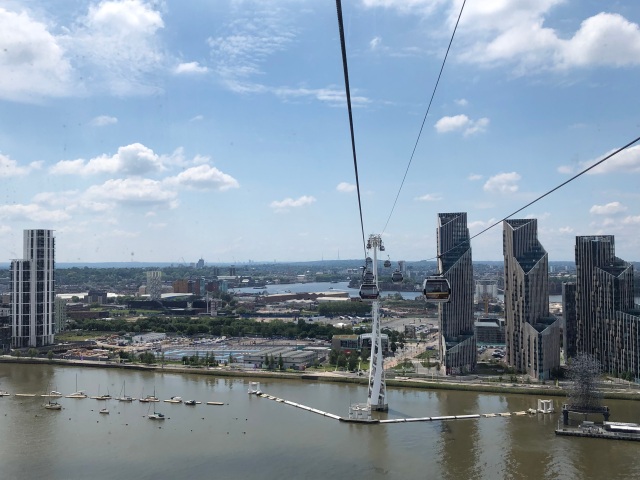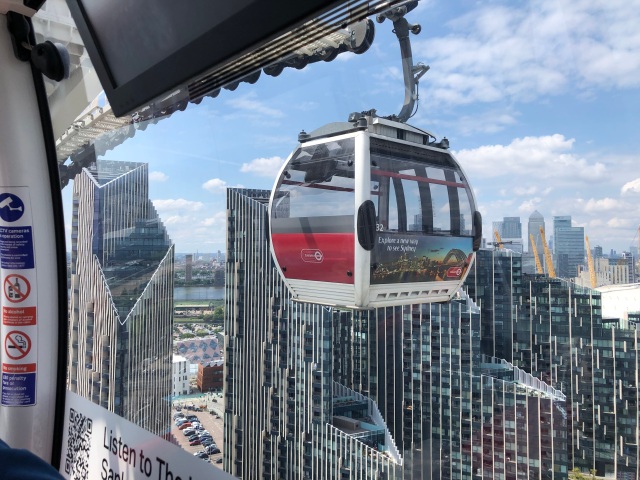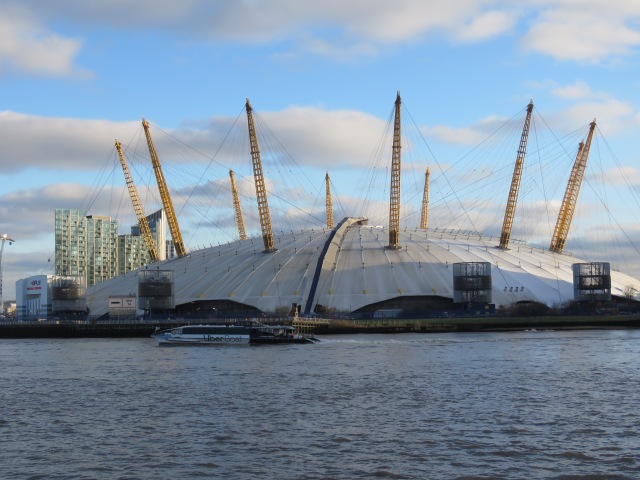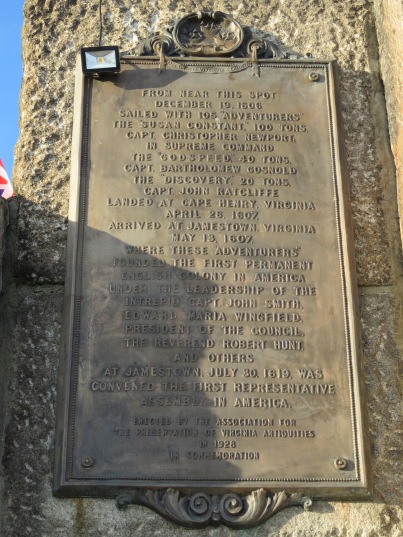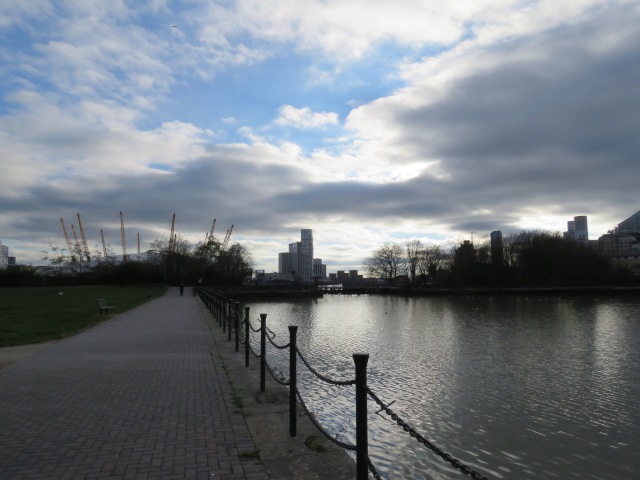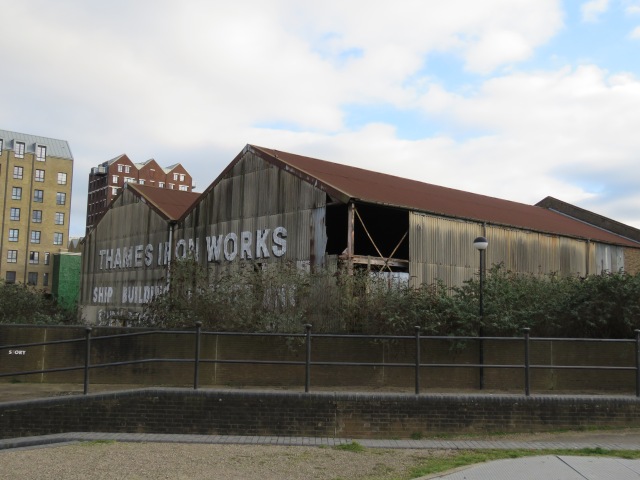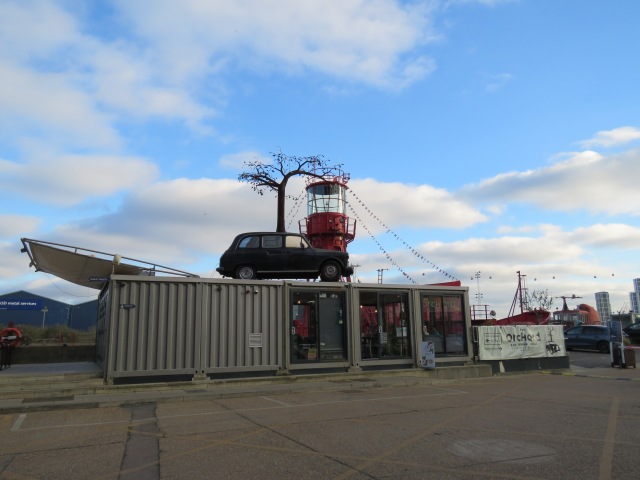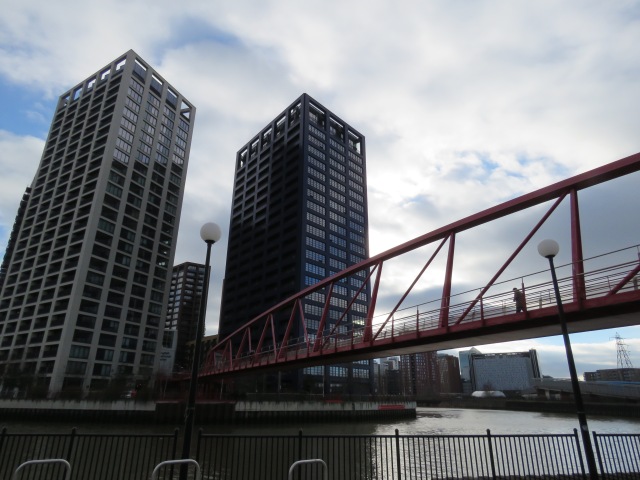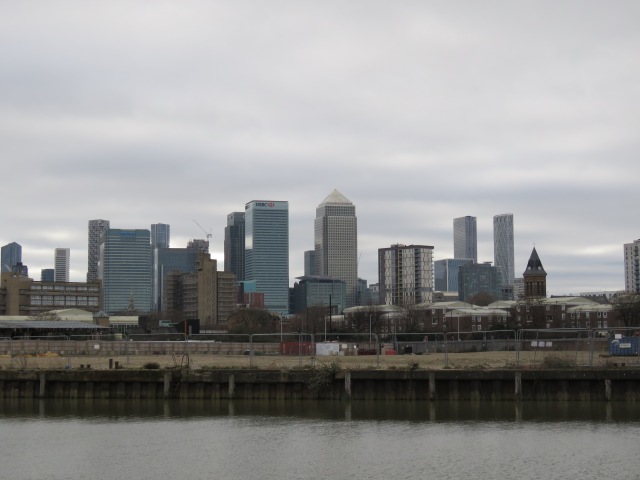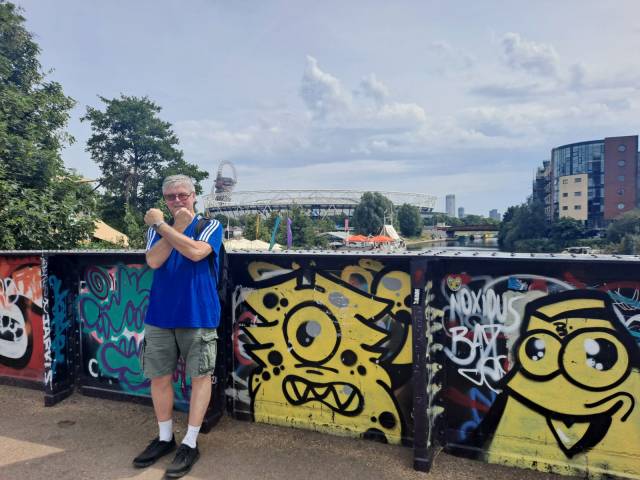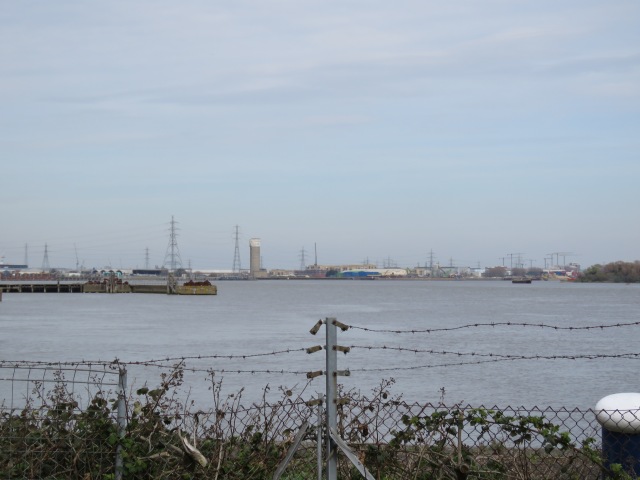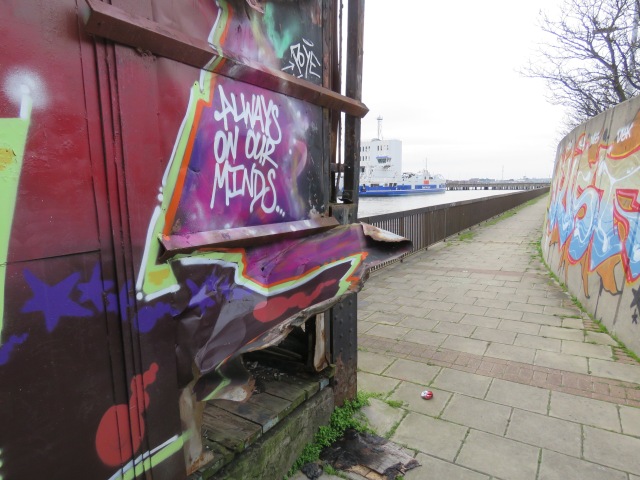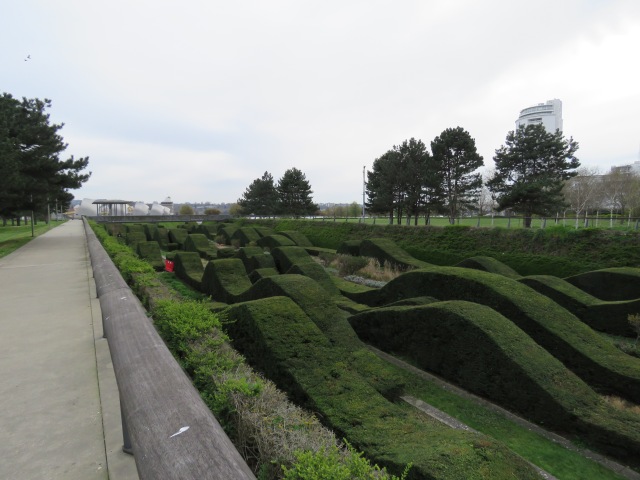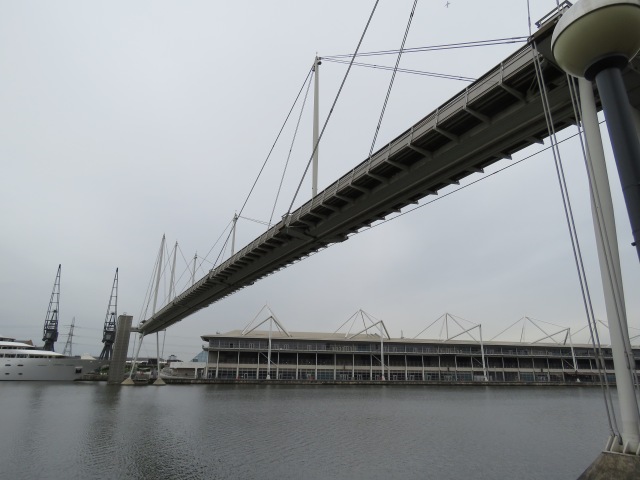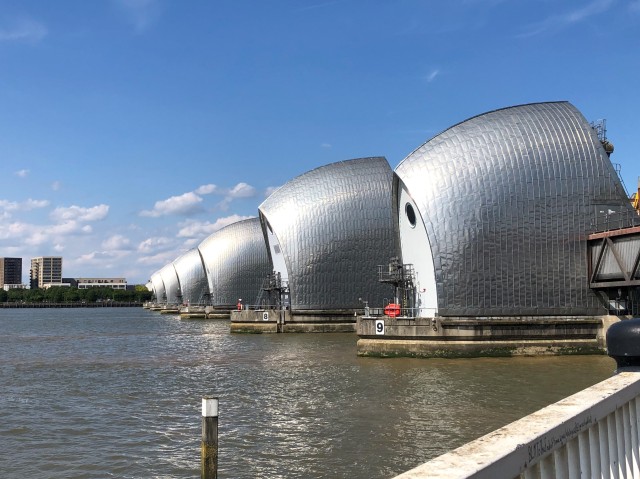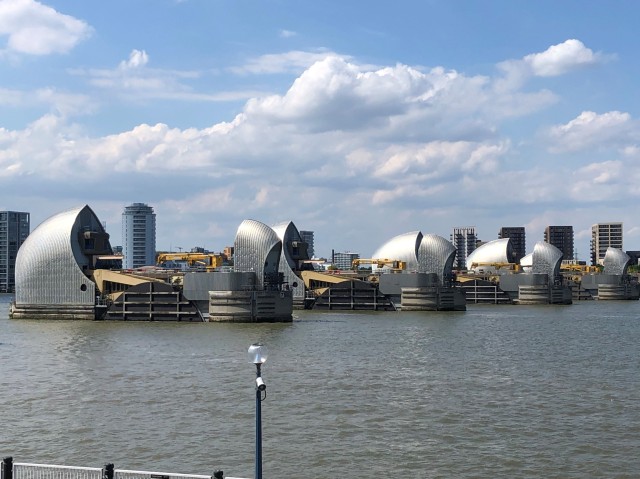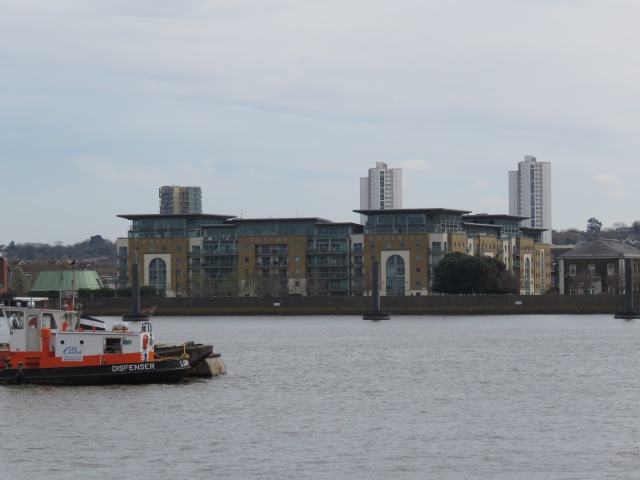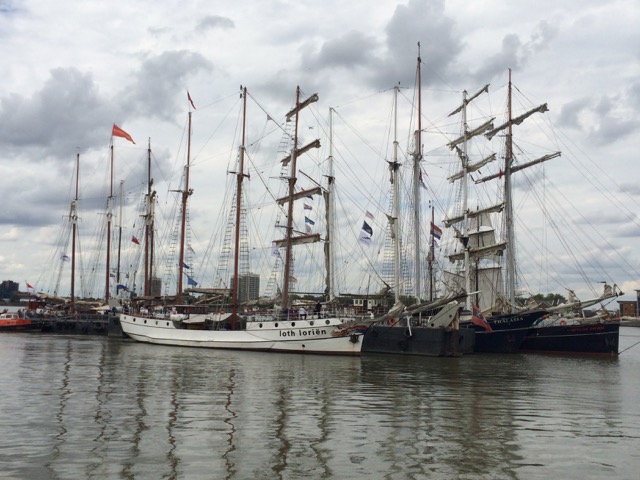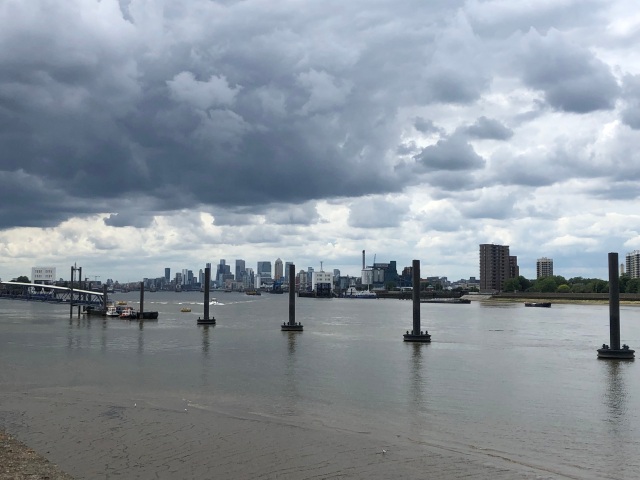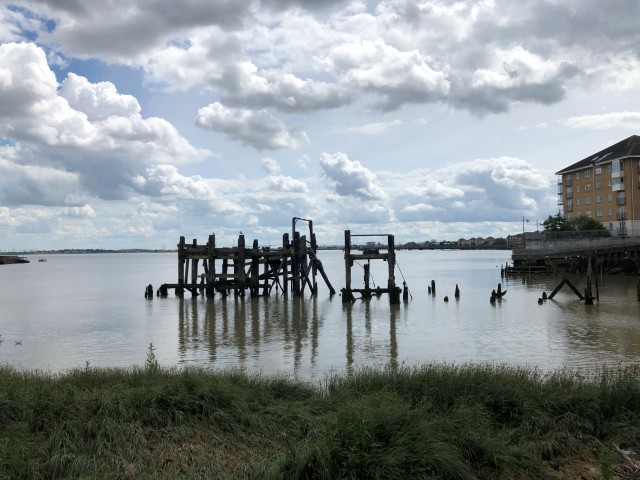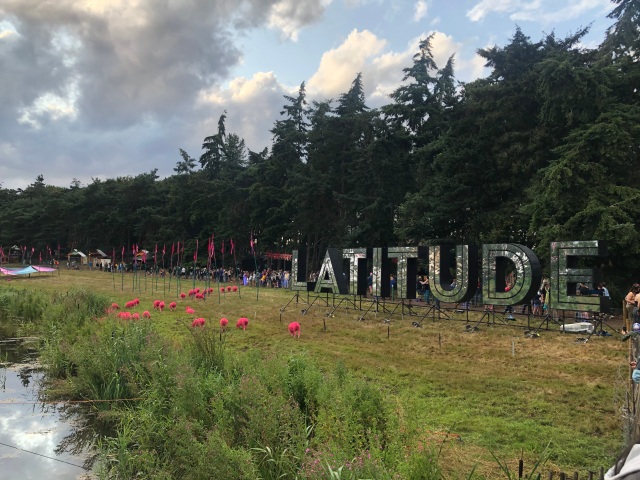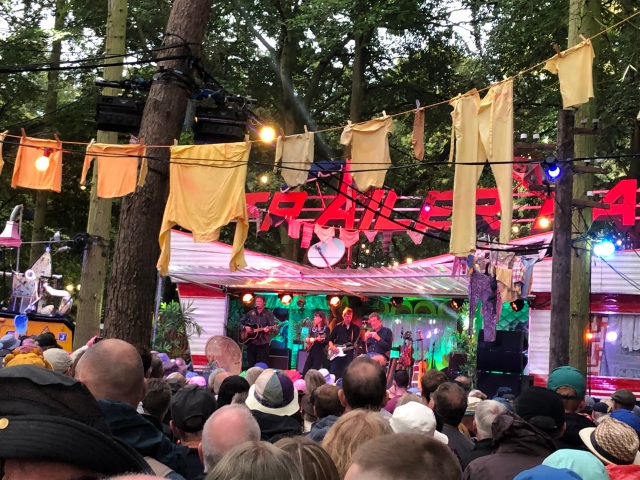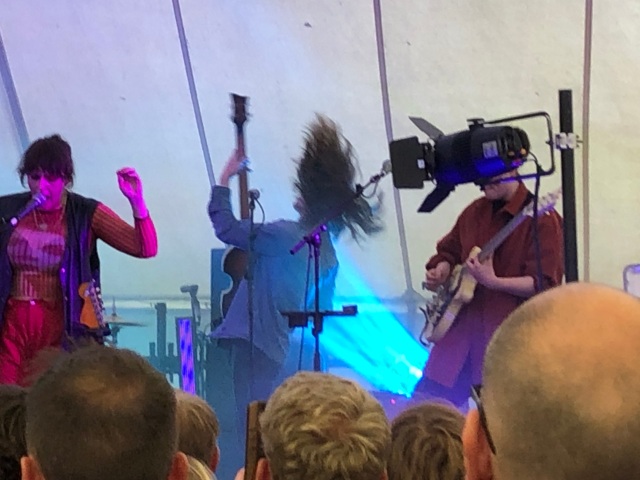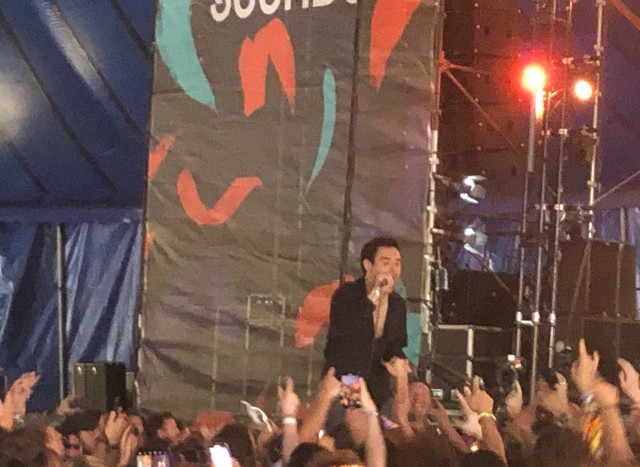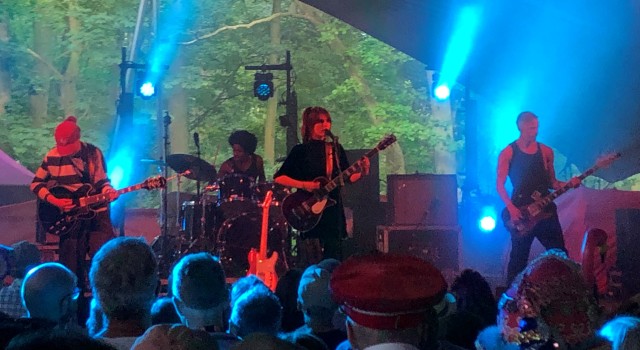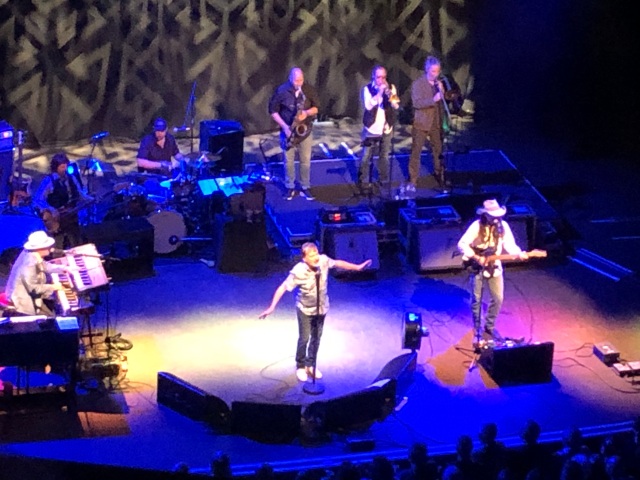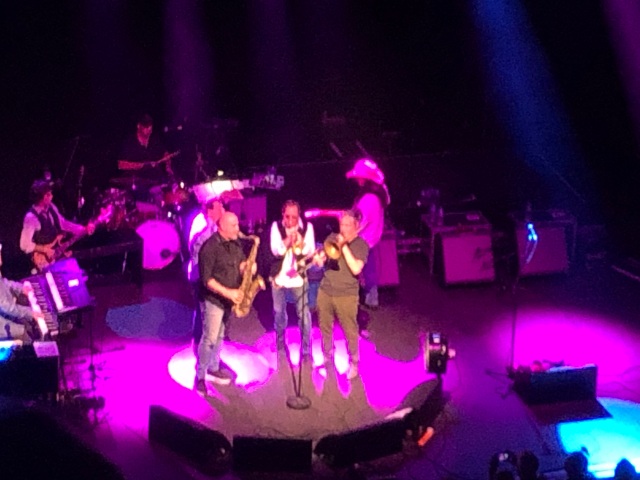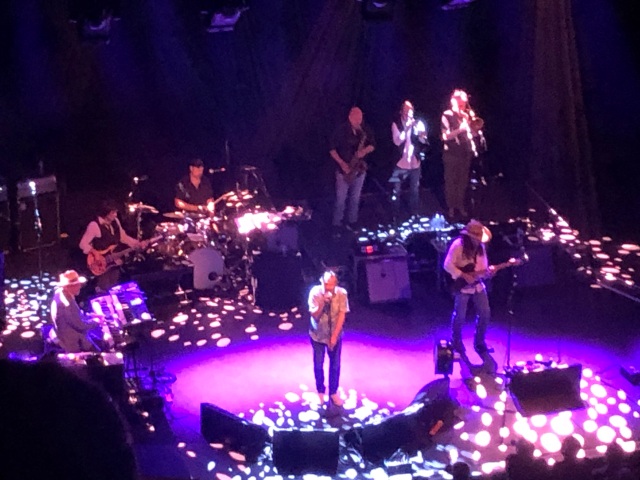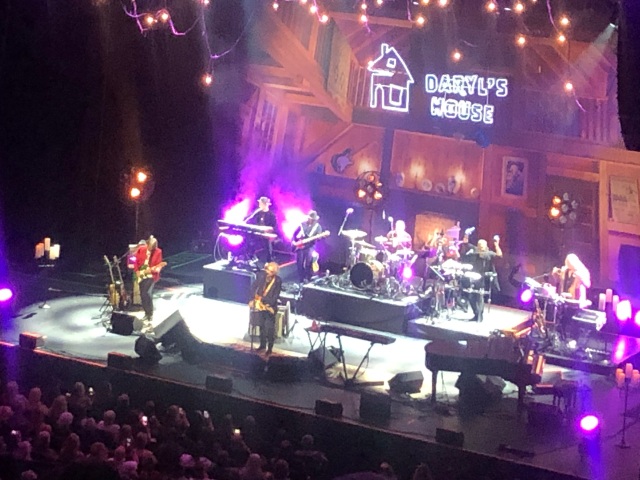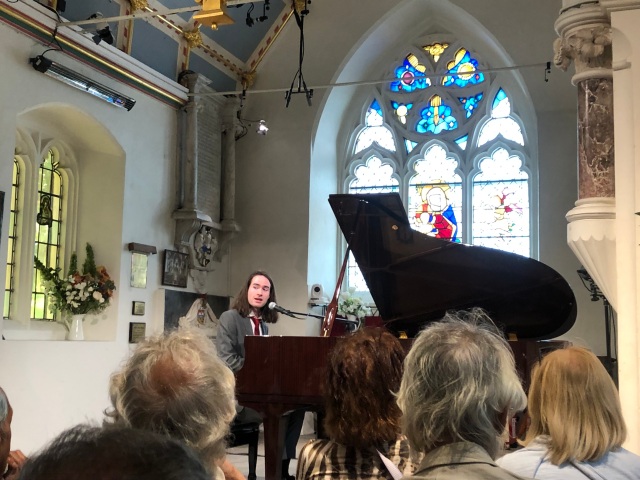
Wilco on the main stage, Thursday night
My seventh End of the Road since Jon and I started coming in 2016, and quite possibly the best. Mind you, I think I often say that! But the line-up had some of my favourite bands of the moment, and I’d taken the trouble to listen to the excellent EOTR 2023 playlist on Spotify, so had a list of new artists I wanted to find out more about. On top of that, the weather, apart from some rain on Thursday, was perfect; and Jon and I once again took the glamping option, which meant a ready-assembled tent, a comfortable and warm bed, a handy local café and decent showers. Little things can make quite a difference to the experience.
But of course it was all about the music – with a little bit of spoken word in the mornings.
Thursday 31 August
There was drizzly rain most of the afternoon and it felt a bit chilly, but thankfully the rain stopped just before performances got going. There was another burst later, but that was it for the festival. Summer arrived just in time!
The first band we saw, in the Folly tent (formerly the Tipi) was Beige Banquet, a London-based five piece whose frenetic jerky riffs bear comparison with the likes of Duds, Crack Cloud, Squid and going further back, Gang of Four. So much begins with the Gang of Four. I really enjoyed their high energy set, particularly the excellent closing song Wired/Weird.

The Last Dinner Party, on the main Woods stage, were a mixed bag, just as they were at Latitude. It was a lively show, with singer Abigail throwing herself around and occasionally revealing her inner Kate Bush. Once again, I heard quite a lot of Sparks in the sound, including the intro to their now-anthemic hit Nothing Matters. That is a very good pop song. They are obviously going places.


Brigitte Calls Me Baby in the Tipi were completely new to me until I heard their song on the playlist, Eddie my Love. I liked its 60s feel – or was it 80s? They hail from LA and play rock’n’roll which is one part Strokes, one part the Smiths and the rest an amalgam of 60s R&B and surf music. So nothing new, but the songs were well-constructed, with catchy melodies. Singer Wes Leavins is a stylish front man with more than a touch of Smiths-era Morrissey. A fine performance.

Wilco headlined the main stage. I used to listen to the band quite a lot back in the 2000s. I liked the mix of Americana with occasional left-field twist. The formula remains the same, with a strong emphasis on the Americana. Singer Jeff Tweedy, somewhat more portly than he used to be, was in fine voice throughout. But there were some searing guitar solos at unusual moments and an extended piece at the end which was full-on motorik beats and screeching guitars. Spiders (Kidsmoke) it’s called. A rousing end to the first evening.


Friday 1 September
Literature
Jon and I went to all three of the book talks down at the Talking Heads stage today. It’s a beautiful setting amid the trees, with the Dorset hills in the background. The straw bales were still a bit damp, but I had a plastic bag with me, which prevented wet bum syndrome! First up was scientist and nature writer Amy-Jane Beer who published a book about rivers called The Flow last year. As a bit of river obsessive myself, I enjoyed the talk, though there was rather a lot about kayaking. Next was Harriet Gibsone, music writer, Guardian journalist and now a freelancer. She’s written a memoir called Is it OK? which delves into her relationship with the internet, her obsessions – which include Coldplay singer Chris Martin! – and grappling with depression, the menopause and motherhood. Sounds heavy, but she was actually very funny and incredibly candid. A very engaging interview. Finally Emma Warren, a music journalist specialising in the dance genre – she’s also a DJ – talked about her recent book Dance Your Way Home; A Journey through the Dancefloor. She did it without an interviewer, which was a mistake, as she lost the benefit of interaction; but her passion for all things dance, including kitchen moves and school discos, came through strongly. I liked the way she talked about dancing your history and your story (which she distinguished). In fact, later in the day, as a woman in front of me at Angel Olsen danced a peculiar dance, all hand movements, I thought, she’s dancing her history – or maybe it was her story.
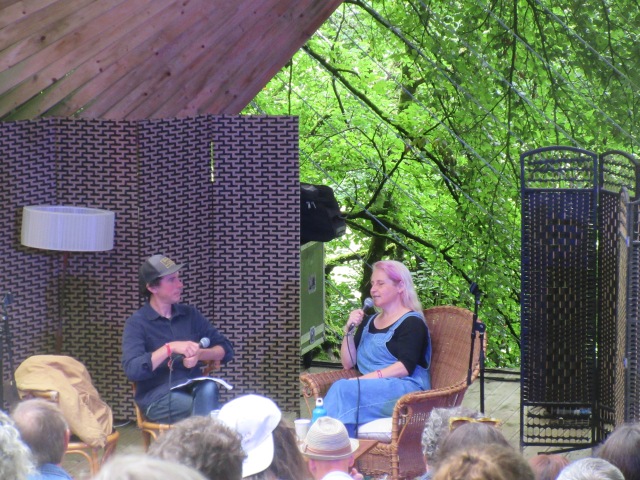
Amy-Jane Beer

Harriet Gibsone on the right

Emma Warren

That setting
Music
After a brief excursion to Ursa Major Moving Group (one person!) in the Folly, which was not for us, the first music of the day was American band Say She She. If you enjoy the recreation of the 70s disco and soul sound, this band could be for you. The crowd were soon dancing. I enjoyed it for about 20 minutes then got a little bored. Next up, on the Garden stage were Horse Lords. I’d been intrigued by the track Zero Degree Machine on the playlist, which combined some African-style guitar with a crunching beat and strident sax. The show had all those things and more. It was avant garde jazz meets math rock, pretty intense. Played by geeky-looking bunch of Americans from Baltimore. Intriguing – further exploration required.

Say She She

Horse Lords



It then got even better on the Garden stage, with Daniel Norgren. Exquisite swamp blues, straight out of Mississippi, or maybe Chicago. Daniel’s first extended guitar solo over a gently rolling beat was a thing of great beauty. Standing in the sunshine it brought a tear to my eye! It took me back to a similarly revelatory show many years back at Latitude, when I first came across Duke Garwood. This was the essence of America – and Daniel and band looked straight out of 70s blues rock casting. I googled his name, only to find that he was in fact Swedish! Of course it didn’t stop me loving every note he played. A wonderful gig.


It was the Garden stage again 45 minutes later for the Mary Wallopers. What a hugely entertaining show this was. The band are from Dundalk in Ireland, and their music was a cross between the Dubliners and the Pogues. Of course those two bands, from different generations but with a shared heritage, did come together from time to time. The Mary Wallopers continue the tradition, combining rousing stomps and forlorn ballads. The themes are timeless: economic struggle, exile, lost love, the booze. The patter between the songs is good natured and humorous, even when the content of the songs is serious. But most of all, it’s a big party and everyone is invited. The crowd was really rocking by the end, front and back. I’m not sure I’ve seen it quite like that at the Garden before. I’ll be looking out for a London show to repeat the experience!


After the intensity and energy of the three Garden shows, I felt like something a little more relaxing, and wandered down to the Talking Heads stage for Sessa, a Brazilian guitarist and singer. He played a set of gentle ballads on his acoustic guitar in a kind of bossa nova style. He was accompanied by a backing vocalist, Paloma, who added to the dreamy effect. And all this in the gorgeous setting of the Talking Heads stage, with the trees lit up in reds and blues. Truly, my soul was soothed.
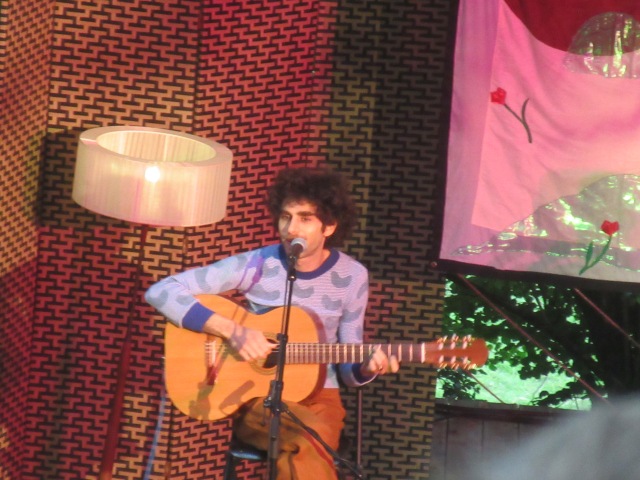


Final show of the night was Angel Olsen, headlining the Garden stage. I’ve always enjoyed her music, both the heart-rending ballads and the more trenchant rockers. Recently she’s delved more into country too. All were present tonight, in something of a greatest hits show. She played with a real confidence that comes from success, and was relaxed and humorous in between songs. It was noticeable how much the women in the audience were relating to it – it’s in the lyrics, I think. I was delighted that she played Sister, which is my favourite song of hers, and features a couple of searing Neil Young-style guitar solos. Shut Up Kiss Me packed a punch, and All the Good Times oozed country heartbreak. And it still sounds a bit like Good Year for the Roses! A very satisfying end to the first full day.


When I say final show, I mean for me and Jon. There is plenty of entertainment into the early hours, notably in the Folly tent, where there are always a couple of surprise shows featuring some of the livelier bands from the day’s line-up. Looking back at my 2016 review, I was reminded that I went to a couple of late shows: Wild Beast in the Big Top and the Big Moon in what was then the Tipi tent. In between we went to see Natasha Khan of Bat for Lashes do some DJ’ing. These days though, Jon and I prefer to pace ourselves. Need to retain energy for the whole weekend. Needless to say the younger members of our group did not follow the same strategy!
Saturday 2 September
I skipped the literature talks today, had a leisurely breakfast, read a bit and wrote up some notes in the sunshine. So the first thing today was Mabe Fratti and her band on the Garden stage. Mabe is a cellist and singer. She’s Guatemalan, based in Mexico. She came to my attention in 2021, with her extraordinary album Sera Que Ahora Podremos Entendernos? Translated that’s Will We Be Able to Understand Each Other Now? It combined wildness and beauty in equal measure, and the sounds she generated from her cello were remarkable. Kath and I saw her live at King’s Place in 2022 in a captivating show. That one had moved on from the music of the first album, but today she returned to it. And it was awe-inspiring. Together (I think) with guitarist Hector Tosta – with whom she’s about to release an album, Vidrio, under the name of Titanic – she created a beautifully atmospheric soundscape, even under the blazing sun. Over that her vocals wafted, while the drummer added an unobtrusive but sympathetic beat. I was truly engrossed, and I could see that others around me were too. A festival highlight, for sure.


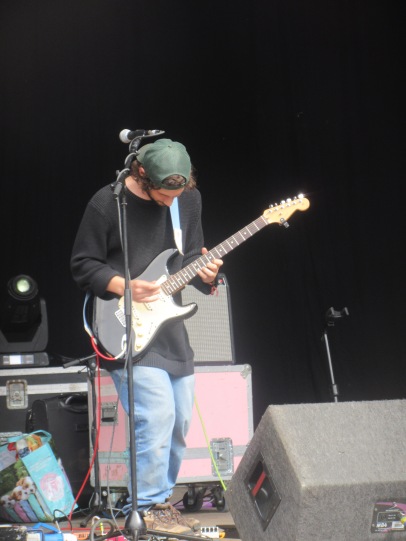

Irish folk singer John Francis Flynn was another playlist discovery. I loved his haunting rendition of Come My Little Son, which tells the tale of a father’s regret at being away from his son as he works on England’s motorways. John cuts an imposing figure: a big man, dressed in black, with a bushy black beard. But he sings and plays with great sensitivity. The music ambled by, almost soporific in the afternoon sun. There were a couple of perkier numbers towards the end, and a lovely version of Come My little Son, which he said was a Ewan McColl song. That made sense. John Francis Flynn continues the tradition.


After a break back at the tent, we returned to Kokoroko on the main stage. The perfect band for a sunny afternoon. Joyous sounds melding jazz funk, salsa, Afro-beats. The trumpet and trombone to the fore, embellished by funky guitar and insistent drum and bass. One or two punchy guitar solos added to the mix. The crowd responded in the only way they could – with a lot of dancing. Kokoroko know how to make you feel good!

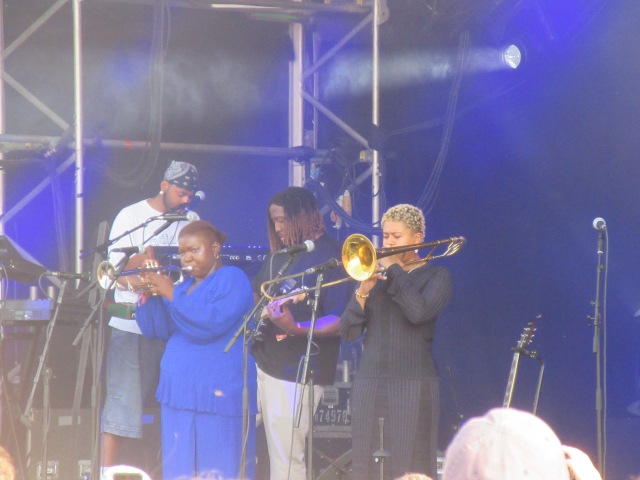
There was a secret guest scheduled for 7.15 on the main stage. Louis found out that it was going to be Wet Leg, who seem to have conquered the world since the release of their insanely catchy song Chaise Longue in the summer of 2021. Jon and I can lay claim to have been early adopters, having seen them play to a capacity crowd on Latitude’s Alcove stage in July that year. But I must admit that I found the debut album a bit disappointing, a bit of an indie/glam rehash. Nothing much to distinguish it, except for that glorious first single. They felt like a bit of an industry hype, and as they gained mainstream success I lost interest. But given that they were playing EOTR I had to see them. And they were good. Not sensational, but entertaining, and clearly enjoying the unexpected fame. And of course the last song was Chaise Longue – played a little differently, but still a full-on celebration.

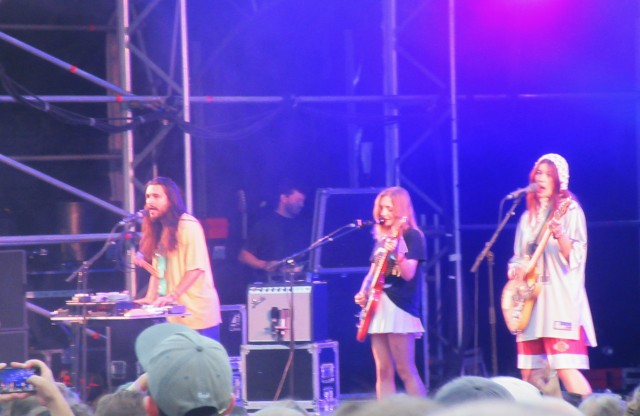
Jon and the others left Wet Leg after about 15 minutes as they are massive Crack Cloud fans, and wanted to see the whole of their set on the Garden stage. I went along after Wet Leg had finished and saw just over half the show. I’ve not been that keen on them in the past – we saw them once at Green Man and I found them a bit too shouty. But this evening I was very impressed. Their music is in a similar vein to Beige Banquet’s, but more complex, the lyrics more profound. The band, who are Canadian, met while recovering from drug addiction, something which clearly informs their lyrics. The music is intense and incredibly rhythmic. Most impressive was the singer and drummer Zak Choy. To be able to sing so passionately and keep the beat driving on – holding the rest of the band together – is some feat. And I was delighted that the one song I know well, Drab Measure, was played at the end. Superbly. A great performance.


After a few songs from the indie rockers Lime Garden (which I’m struggling to recall) it was the Garden stage again for our last show of the night, Arooj Aftab. An interesting choice of Saturday headliner – not one to get people up and rocking – but EOTR is never predictable. I saw Arooj play a wonderful show at the Barbican earlier this year, with pianist Vijay Iyer and bassist Shahzad Ismaily. That performance centred on their album Love in Exile; tonight she was back to her earlier songs, including those from the excellent 2021 album Vulture Prince. She was accompanied by a harpist and double bass player. Together they wove an eerie, enchanting spell. Arooj’s voice was a thing of wonder as it wafted through the night air. Music to dream by.
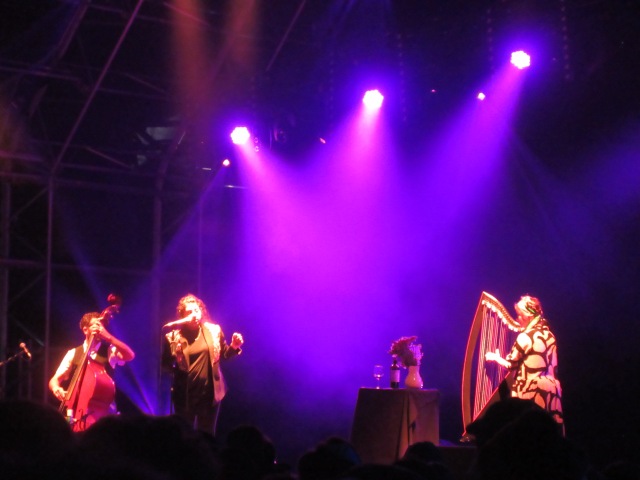
Jon and I had planned to see electronic dance duo Overmono in the Big Top. But by the time we got there it had reached capacity, and there were queues to get in. We decided to call it a day. Louis reported the next day that they had been brilliant. But there’ll be another time.
Sunday 4 September
Of all the days this was the one I’d been most looking forward to. Four of my current favourite artists all playing: Indigo Sparke, Gretel Hanlyn, Biig Piig and the Murder Capital. No clashes. Bring it on!
Literature
One literary talk for me today, which was Richard Morton Jack being interviewed about his book Nick Drake: A Life. This may well be the definitive account of Drake’s short life: although not an authorised biography as such, Morton Jack was given access to all of Drake’s papers and possessions by his sister Gabrielle, along with the diary that his father kept when Drake was back home, suffering from the mental illness which eventually led to his death at the age of 26. The discussion was fascinating. It focused on Drake’s early life, before he went to Cambridge University and made his now revered trio of albums. In doing so it debunked the myth that Drake was always an introverted, tortured soul, a doomed poet. Far from it, it seems. They essentially ran out of time before heading to more familiar territory; but it was good to hear the positive aspects. I’ll be buying the book.

Music
First music of the day was Australian band Floodlights on the Garden stage. The playlist track Lessons Learnt reminded me a little of a New Zealand band from the 90s, the Mutton Birds. Live, the band had one of those big rock sounds that I associate with Scottish bands like Big Country, Simple Minds and Glasvegas, but the history of indie music was written into their songs. Nothing particularly original, though the EOTR programme talked about vivid lyrics painting landscapes of the Australian bush. I thought they were an engaging band with good, strong songs and merit further exploration.


We caught a little bit of Divorce on the main stage – surprising countryish – and then tried Madmadmad in the Big Top. The playlist track Gwarn gave me Talking Heads vibes, which is always a good thing. Live the three of them, armed with an array of keyboards and effects, pounded out some hard-rocking dance beats, embellished in one song by a raging guitar. An in-yer-face sound, which I enjoyed for a few songs, before I started to feel I’d heard enough and could do with something a bit more soothing.

Note the Big Top floating tiger – referred to later!
I hopped over to the Folly, where Australian singer-songwriter Gena Rose Bruce was just starting her show. She picked at an acoustic guitar while her companion Connie, an old school friend, threaded gentle electric guitar patterns around the melodies. Gena’s singing reminded me a little of Faye Webster; so too did the songs. That’s a recommendation! An unassuming but highly enjoyable performance.

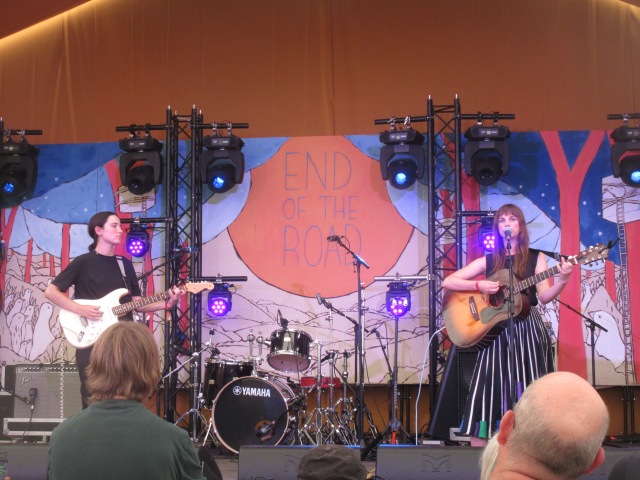
That set me up nicely for another Aussie singer-songwriter: my favourite of the moment, Indigo Sparke. Her 2022 album Hysteria was my album of the year; its predecessor, Echo, made No2 in 2021. I find her songs captivating, subtly moving. There’s a real beauty – and sadness – in her voice. She does have a band back in the US where she is based, but once again – I’ve seen her twice recently – she was solo, except for the last song where a friend accompanied her on vocals. She played a familiar mix of songs from her two albums, plucking a rather splendid green acoustic-electric guitar. She had the crowd entranced – no talking during the songs for this one. I found myself almost in a dream-like state; but that ended abruptly when she announced that she’d come to her last song, a Cat Power cover. Up to that point she’d only played half an hour. After that last song she could have played a couple more; but in fairness it was very hot and maybe that was as much as she could manage. A case of quality rather than quantity today, and I really would like to see her with a band sometime.


After a break, Jon and I headed up to the main stage to see soul veteran Lee Fields. He is an absolutely classic old school soul man, Resplendent in shiny green suit, he threw a few James Brown shapes and sounded like a cross between Al Green and, especially on the ballads, Otis Redding. The energy he brought to the stage, aged 72, was impressive. His old school-ness grated a little when he talked about the ladies, and he elicited a groan when he asked one man at the front whether the woman next to him belonged to him. He meant well, of course and he had the crowd eating out of his hand for the most part. His band were super-slick, his voice soulful to the nth degree. A perfect sound for a gorgeous late summer’s day.


I so love the contrasts you get at festivals. From the sweet soul of Lee Fields we launched into the wild punk riffing of Panic Shack in a hot and sweaty Folly tent. Panic Shack are four women with a male drummer, and they have attitude to spare! Any stupid man who does them a disservice gets a full-on riposte in their venomous – and amusing – lyrics. They are best known thus far for their song The Ick, which describes going on a date which starts to go wrong when the singer discovers that her companion puts the milk in his tea first! And then he shushes her in the cinema. It’s over. The energy of the songs was infectious, and they did it all with smiles on their faces. They threw in a few amusing little dance moves too. It was all going so well until, after about 25 minutes, there was a power cut. They took that in typically good spirit and came back on for another rousing ten minutes before there was another power cut. That finished off the set unfortunately; but Panic Shack made a really positive impression.


Fortunately power was restored in time for Gretel Hänlyn to have time to tune up before her show, and it stayed on. Gretel said that the generator had been in a pool of water. Presumably some kind of leak. So that was a relief. The band started up the riff for Apple Juice and they proceeded to play the best set I have seen them do yet. Latitude was good, but this was even better. It no doubt helped that I was quite close to the front, but they are exuding a confidence these days that comes from the hard graft of live shows. The crowd was a good size and Gretel seemed very pleased and energised by that. The melodies were strong and clear; the riffs packed a real punch. I loved it all, but particularly enjoyed Wiggy and Drive amongst the uptempo songs and the two ballads, Connie – which Gretel declared her favourite song – and In the Water. As is now customary, the show ended on a high with Today (can’t help but cry), which belies its title. Great stuff.


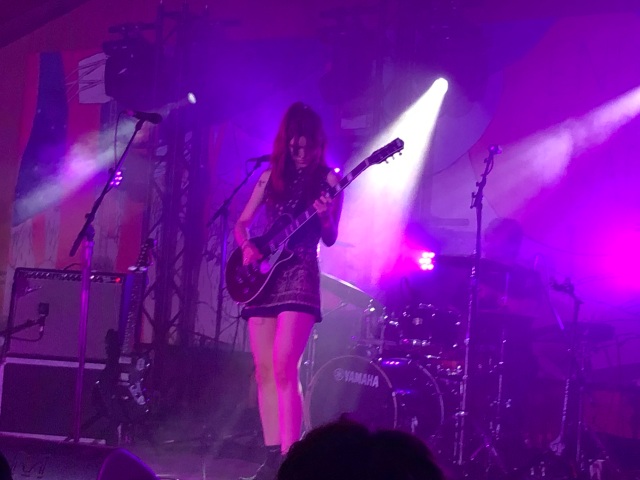
Straight over to the Big Top next for Biig Piig. When I got there the gates were shut at the front. But a side entrance was still open. I got in and made my way further back to get a clear(ish) line of sight. The place was heaving. Jessica – she who is Biig Piig – was awestruck by the number of people that had come to see her. She has come a long way over the last year. Over the course of the show, as some people drifted out, I was able to get quite near the front. Still couldn’t take a decent photo though – she is a non-stop bundle of energy, bouncing from one side of the stage to the other. The set was similar to the one at Electric Brixton in March, with a good selection of her earlier jazzy grooves, some of the lyrics sung in Spanish (Jessica spent part of her childhood in Spain). Towards the end the tempo accelerated, kicked off by a banging version of Switch, followed by Feels Right and finally Kerosene. Phew! It definitely felt right.


Three great shows, Panic Shack, Gretel Hänlyn and Biig Piig, in succession. Could it get any better than that?
The one I was waiting for was the late show in the Big Top: the Murder Capital. First I went down to the main stage to catch a bit of King Gizzard and the Lizard Wizard. They’re an Australian ensemble who are remarkably popular with the youngsters despite the fact that they play an updated version of 70s prog rock. Not my favourite genre, which explains why I don’t know their music very well. That said, Louis and Gab are huge fans, so I thought it was time to give them a go. I didn’t see the others as they were right at the front, but I got a good view and watched for about 45 minutes. Twenty-five of those were all one piece: an extended guitar and keyboard work out. And I rather liked it – it had a rolling groove and the band are very energetic as they go about their business. It’s well-presented too, with vivid lighting and an ever-changing psychedelic backdrop. I could happily have stayed for the whole show, but I wanted to grab some food before that final event.


Could it get any better?
You know the answer. The Murder Capital were unbelievable. Unbelievably good. As good as it gets. A truly amazing concert. They just seem to get better and better. More drama, more swagger, more everything. I got there quite early – I wasn’t going to miss any of this one – and let the others know where I was. They found me before the show, so we enjoyed it together. The structure of the show was similar to Latitude, but there were a few changes of song. They started with The Stars Will Leave Their Stage, which has a feel of Bowie at his most grandiose. And singer James McGovern upped the grandiosity. After that he quipped, this is the first time I’ve had to sing staring at a tiger’s arse, referring to the model floating above the crowd (see Madmadmad photo). The grandiosity is left for the songs! And then it was time to rock, with Return my Head and a pile-driving More is Less, by which time full scale moshing had erupted. We had a good view of that, standing just to the side of where the ripple effect ended. You learn these things over the years!
We then had the sequence of slower but no less dramatic songs, featuring for the first time that I have seen, the brilliant Slowdance I and II: the latter a searing instrumental, which they reworked considerably from the recorded version tonight. It involved the band forming a huddle at one point, as the guitars thrashed. Things then started to build to the climax with a scintillating For Everything. Our appetites truly whetted, it was time for the energy rush of the final three: Feeling Fades, Ethel, Don’t Cling to Life. Anthemic, chaotic, exhilarating. The band and crowd lit in deep blue. Truly, truly sensational.
We came out of the Big Top buzzing. It’s not the first time that the Murder Capital have sent us away on a high – it happened in the Tipi tent on the Sunday of the 2019 festival. But this was different scale. Right now there cannot be many better live bands around. They’re so good I’m going to see them again in November, in Glasgow. That will be something else.






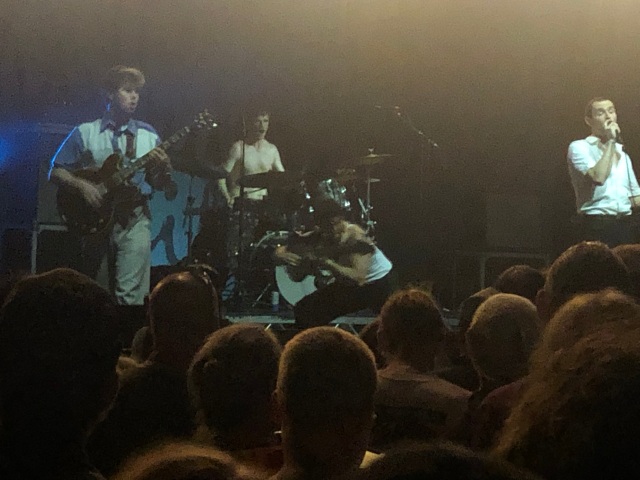



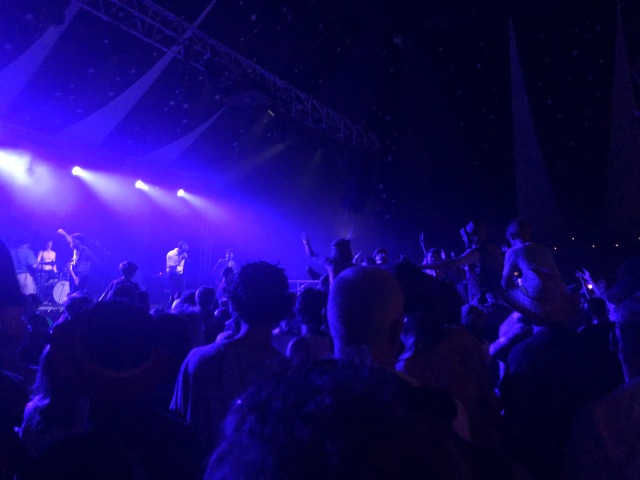

And so another exceptional End of the Road drew to a close. The best ever? There’s always a temptation to say that about the one you’ve just experienced, especially when it ends on a high like tonight. Let’s just say that End of the Road does the business every time. I’ve already bought my ticket for next year!

All over
